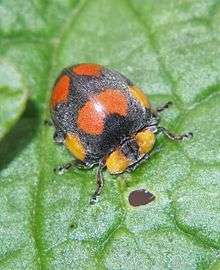Henosepilachna guttatopustulata
| Henosepilachna guttatopustulata | |
|---|---|
 | |
| Scientific classification | |
| Kingdom: | Animalia |
| Phylum: | Arthropoda |
| Class: | Insecta |
| Order: | Coleoptera |
| Family: | Coccinellidae |
| Subfamily: | Epilachninae |
| Genus: | Henosepilachna |
| Species: | H. guttatopustulata |
| Binomial name | |
| Henosepilachna guttatopustulata Fabricius, (1775) | |
Henosepilachna guttatopustulata, the Large Leaf-eating Ladybird, is a species of ladybird[1] endemic to parts of Australasia, specifically New South Wales, Queensland, the Bismarck Archipelago, New Guinea, New Hebrides and Solomon Islands.
Henosepilachna guttatopustulata is a member of the subfamily Epilachninae. Accordingly it is herbivorous; both the larvae and the adults eat the foliage of solanaceous plants. In addition to feeding on native species and on introduced weeds such as Solanum nigrum, it attacks cultivated plants such as Duboisia spp., egg plant, potato and tomato.[1]
The species causes further damage by acting as a vector for Solanum nodiflorum mottle virus.[2]
H. guttatopustulata is the host for the parasitic chalcid wasp Uga colliscutellum.[3]
Description
H. guttatopustulata is 7–9 mm in length, with the distinct rounded elytra or fore wings typical of ladybirds. Apart from their coloured spots, the elytra and pronotum are black, while the propleura, the sides of the prothorax, are yellow or yellowish brown. Each elytron bears three spots. The spot on the top of the midline is reddish brown, as is the spot on the rear of the elytron. Another spot on the lower front part of the elytron also is yellow or yellowish brown.[1]
References
- 1 2 3 Li, C. S. (1 August 1993). "Review of the Australian Epilachninae (Coleoptera: Coccinelledae)". Australian Journal of Entomology. 32 (3): 209–224. doi:10.1111/j.1440-6055.1993.tb00577.x. Retrieved 20 March 2013.
- ↑ Meier, M.; Olspert, A; Sarmiento, C.; Truve, E. (2009). "Sobemovirus". In Brian Mahy, Marc Van Regenmortel. Desk Encyclopedia of Plant and Fungal Virology. London: Academic. p. 313. ISBN 9780123751485. Retrieved 20 March 2013.
- ↑ Szawaryn, Karol (2011). "A New Species of Henosepilachna Li" (PDF). Annales Zoologici. 61 (4): 685–689. doi:10.3161/000345411x622525. Retrieved 20 March 2013.